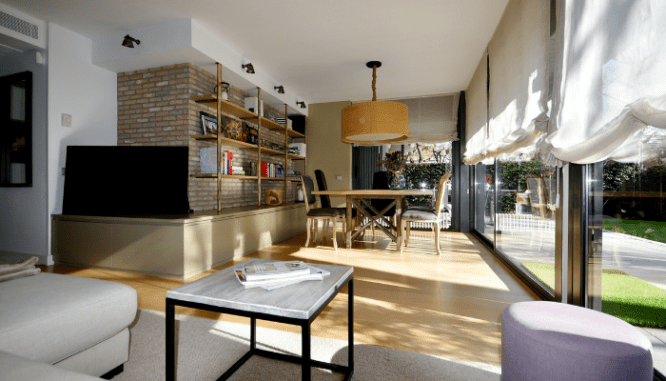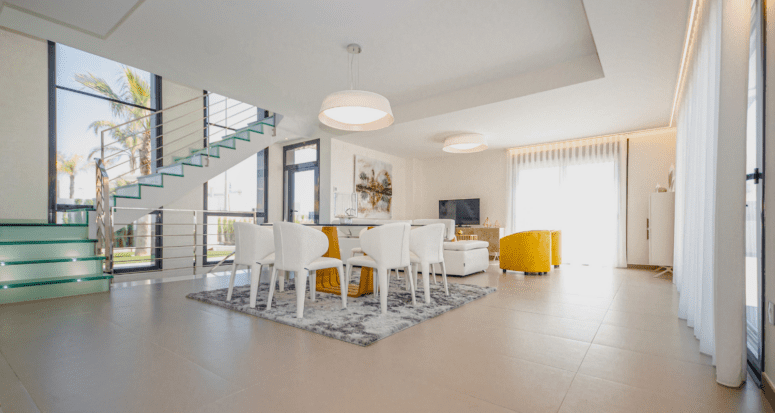‘I’m on a Call!’ Is the Open Concept Floor Plan Going Out of Style?
- Published on
- 4 min read
-
 Melissa Rudy Contributing AuthorClose
Melissa Rudy Contributing AuthorClose Melissa Rudy Contributing Author
Melissa Rudy Contributing AuthorMelissa Rudy is a seasoned digital journalist with 15 years of experience writing web copy, blog posts and articles for a broad range of companies. When she can’t buy or sell homes, she settles for the next-best thing: researching and writing about all things real estate-related.
At HomeLight, our vision is a world where every real estate transaction is simple, certain, and satisfying. Therefore, we promote strict editorial integrity in each of our posts.
Flip on an HGTV show in recent years and you’d either hear someone gushing over a home’s open floor plan — or bemoaning that it’s too closed off. Since the ‘90s, spacious areas where kitchens, family rooms, and dining rooms all flow together into one communal space have dominated as the preferred living arrangement.
However, when COVID-19 prompted a shift toward remote work and grounded many families at home, it raised doubts in the home design space about the future of the open layout. Theoretically, partitioned spaces give families more options to support multiple people working from home in peace and provide privacy to multiple generations living under one roof.
However, open floor plans have been so beloved for such a long period of time — wouldn’t the trend be hard to shake? To find out whether the open concept is actually going out of style, we talked to some reputable home designers and home builders on the matter.
We asked them: Are walls making a comeback, or will these merged spaces be the layout of choice despite a pandemic’s best efforts to encourage separation? Here’s what we found.

What’s an open layout, and what’s so great about it?
“If you’re in one room and can see most of another room, that’s an open concept space,” explains Lindsey Putzier, owner and principal designer of Lindsey’s Eclectic Interiors. In most cases, this involves flowing together the kitchen, dining room, and/or living room.
Below are some of the main reasons that homeowners have been gravitating to open floor plans:
- They like being able to prepare meals while entertaining guests or talking with family
- Without walls acting as a barrier, more natural light can flow through the space
- Parents can maintain a direct line of sight of small children
- There is a better flow of traffic throughout the home
- Open floor plans are more accessible and easier to maneuver for disabled and elderly family members
Below is a photo of an open-concept layout that Putzier designed, where the kitchen, dining area, and family room all flow together.

When did the open concept craze begin?
Back in the ‘70s and ‘80s, layouts were more traditional, with separate spaces for living rooms, dining rooms, and kitchens. Putzier says that was a reflection of families’ lifestyle back then.
“Each room in a home used to serve a very specific purpose,” she says. “If you were hosting a dinner, your guests would only sit in the formal living room and only eat in the dining room. No one entered the kitchen except whoever was cooking. After dinner, men would retire to a different room than the ladies. Children were expected to stay out of the way and not interact with the adults.”
In the ‘90s and early 2000s, there was a shift to the more open, connected spaces as families began to interact more freely and less formally. “Kitchens became the central gathering spot of the home, with overflow seating in the adjacent and open family room being used for gatherings,” says Putzier.
According to a 2017 study by the National Association of Home Builders, 32% of buyers wanted homes with a completely open kitchen-family room layout, while 45% of buyers were seeking a completely open kitchen-dining area. And for homeowners who already owned houses with traditional floor plans, many of them opted to renovate: The 2016 Remodeling Market Index surveyed professional remodelers and found that 40% of their remodeling projects involved removing walls to create more open layouts.
Are walls making a comeback?
When the pandemic hit in March of 2020 and everyone suddenly found themselves working, learning, and doing pretty much everything at home, people found themselves in need of more privacy and separation. As it turned out, all those wide open spaces weren’t ideal for sharing Zoom work meetings, middle-school homework, dinner prep, barking dogs, and crying babies. Reports heralded a return to personal space, as homeowners started seeking out dedicated areas for various tasks and activities.
“For one out of every three homes that I sell, the buyer has conversations about one of the bedrooms being converted into an office,” says Mario Avalos, a real estate agent in Miami-Dade County, Florida.
Even after COVID is behind us, many experts believe that the changes to how we live, work, and learn will stick around. Does that mean we’re approaching the end of the open era and a return to the subdivided homes of decades past?

The ‘sweet spot’ between openness and privacy
While people may want more walls than they did just a year ago, they don’t necessarily want all of the walls. While Putzier’s clients aren’t clamoring for every room to have a door, she is seeing a widespread need for at least one home office with a closed door, if not two home offices. She says many people are also opting to convert formal dining rooms into study rooms for the kids to eliminate distractions.
Many designers and builders are seeing a demand for a hybrid of separate rooms and open areas that allow the flexibility for people to gather together or seek out solitude as the situation dictates. Susan Peters, an interior designer and owner of 9108 designs in Clifton, Virginia, calls it “partial open concept.”
Peters is currently working with a family on an addition and layout design that incorporates a combination of open concept and traditional rooms. She’s planning to remove two or three walls on the main level to create an area to include the kitchen, dining, and family room. On the same level, there will still be a more enclosed laundry area, powder room, and office.
“In this kind of scenario, you get the best of both worlds — the office can be large enough to act as a private office, library and sitting room, and you have a large, open area for entertaining and daily living,” says Peters.
She also points out that you don’t necessarily have to rip out all of your walls to achieve the partial open concept — you can simply enlarge door openings to a double-sized door to help create a more open feel for some spaces.
The final word: Is the open concept on the way out?
While the pandemic may have ushered in a move toward more delineation of spaces as homes are serving more and more functions, that doesn’t mean open layouts have lost all of their appeal. Rather, we seem to be headed toward a happy medium that blends some open spaces with private areas carved out for work, school, and other pursuits.
“Your home doesn’t have to be one big, cavernous space with no walls,” says Brittany Tharp, owner and principal designer of Brittany Tharp Interiors in New Fairfield, Connecticut. “The original truly open concept home with zero separation of space isn’t super practical for most modern families, but the new open concept is finding a nice middle ground, with a combination of open rooms and walled areas. This new version will likely be alive and well for many years.”
Header Image Source: (Ralph (Ravi) Kayden / Unsplash)
